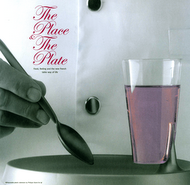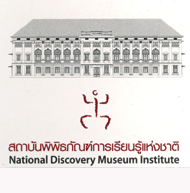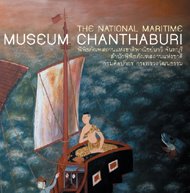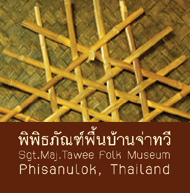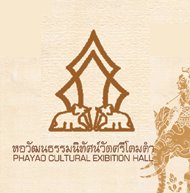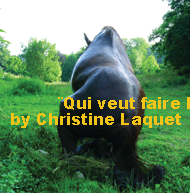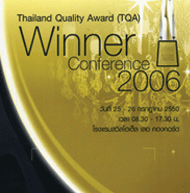
*our client code
0235/2007
The Place & the Plate
The exhibition
and installation of Design,
Gastromomy,Food,Sound,
and Video.
June 29-August 31,2007
The Jim Thompson Art Center
Bangkok,Thailand
The Place & the Plate Printed :
Invitation Card
Guide Book
Insert Paper 









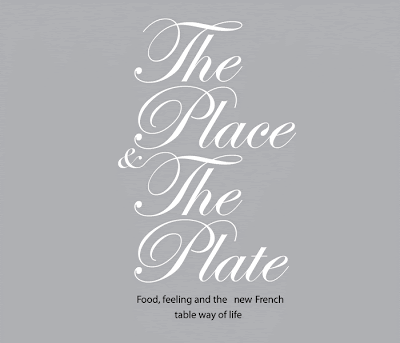
Morisset and I met for the first time over lunch in Bangkok at the Saladaeng Café, one of the Jim Thompson restaurants. He was hunting for an appropriate space for his upcoming show, The Place and the Plate. Without a second thought I strongly recommended the Jim Thompson Art Center to him. No other place or space in Bangkok seemed more appropriate to accommodate the exhibit that he was planning. Not only was the space ideal, but so was the association with Jim Thompson, an American who modernized the Thai silk industry in the 1950’s and 1960’s, and had a reputation for being a wonderful host. He was famous for welcoming visitors from around the world to dine in his unique teak home.
Jim Thompson’s strong interest in architecture, design and art helps to set the stage for The Place and the Plate. He collected hundreds of pieces of antique Chinese tableware including unique five-color Benjarong porcelain made especially for the Thai market. His personal collection of ceramics and Benjarong is on permanent display at the Jim Thompson Thai House Museum. These pieces are so elegant and timeless that they can be studied and re-interpreted in many different contexts.We are delighted to highlight pieces from the Jim Thompson collection in this exhibition.
We would like to thank the James H. W. Thompson Foundation Board of Trustees for loaning tableware from the personal collection of Jim Thompson to be used in a special table setting created by well-known designer André Putman. This arrangement will be displayed in its own separate room. For the main exhibit space, two talented architects Wit Pimkanchanapong and Boonsanga Teo, who specialize in designing multi-disciplinary shows, have created the exhibit in the main hall which encompasses two rooms.
The arrangement is in response to Cedric Moriset’s idea of double rooms which display old and new tableware from French manufacturers and also juxtapose pieces of Benjarong from the James H.W. Thompson Foundation’s collection and those made by Navarong, a redefinition of Benjarong in 21st century developed by Pim Sudhikam and Be Takerng Pattanopas. The concept behind the Thai display varies slightly from the French due to the disrupted development and drastic change that has taken place in the Thai culinary tradition. While the French have re-examined and revived their tableware industry, Thailand has focused on modifying its cuisine by promoting itself as a ‘kitchen of the world’. The movement to launch Thai restaurants around the world is a fascinating new phenomenon. This concept thus makes food and the culinary arts significant not only for everyday life, but also suddenly turns Thai cuisine into a national agenda.
To enhance the experience of The Place and the Plate, we have invited two prominent Thai artists Rirkrit Tiravanija and Pinaree Sanpitak to participate in this project. Both are involved with and interested in cuisine, although each approaches cooking in a different way. Rirkrit Tiravanija has shaken up the western art world by cooking Pad-Thai in world-class museums. For this exhibition he will combine Thai Tom Ka Khai and French Bouillabaisse to serve to the audience on the opening night. Pinaree Sanpitak has developed her ‘breast stupa cookery’ into various types of food. She will work with professional and amateur chefs to prepare traditional Thai dishes, desserts and sweets to serve during the opening night. Her culinary creations will also be incorporated in the Thompson Bar and Restaurant’s menu throughout the exhibition period. To conclude the show, Tiravanija will emphasize how important food is to the art world and to our daily life. He will stage a cooking performance and demonstrate through a social culinary gathering that the ingestion of food can be both for life and for thought.
Gridthiya Gaweewong
Artistic Director and Co - curator
Jim Thompson’s strong interest in architecture, design and art helps to set the stage for The Place and the Plate. He collected hundreds of pieces of antique Chinese tableware including unique five-color Benjarong porcelain made especially for the Thai market. His personal collection of ceramics and Benjarong is on permanent display at the Jim Thompson Thai House Museum. These pieces are so elegant and timeless that they can be studied and re-interpreted in many different contexts.We are delighted to highlight pieces from the Jim Thompson collection in this exhibition.
We would like to thank the James H. W. Thompson Foundation Board of Trustees for loaning tableware from the personal collection of Jim Thompson to be used in a special table setting created by well-known designer André Putman. This arrangement will be displayed in its own separate room. For the main exhibit space, two talented architects Wit Pimkanchanapong and Boonsanga Teo, who specialize in designing multi-disciplinary shows, have created the exhibit in the main hall which encompasses two rooms.
The arrangement is in response to Cedric Moriset’s idea of double rooms which display old and new tableware from French manufacturers and also juxtapose pieces of Benjarong from the James H.W. Thompson Foundation’s collection and those made by Navarong, a redefinition of Benjarong in 21st century developed by Pim Sudhikam and Be Takerng Pattanopas. The concept behind the Thai display varies slightly from the French due to the disrupted development and drastic change that has taken place in the Thai culinary tradition. While the French have re-examined and revived their tableware industry, Thailand has focused on modifying its cuisine by promoting itself as a ‘kitchen of the world’. The movement to launch Thai restaurants around the world is a fascinating new phenomenon. This concept thus makes food and the culinary arts significant not only for everyday life, but also suddenly turns Thai cuisine into a national agenda.
To enhance the experience of The Place and the Plate, we have invited two prominent Thai artists Rirkrit Tiravanija and Pinaree Sanpitak to participate in this project. Both are involved with and interested in cuisine, although each approaches cooking in a different way. Rirkrit Tiravanija has shaken up the western art world by cooking Pad-Thai in world-class museums. For this exhibition he will combine Thai Tom Ka Khai and French Bouillabaisse to serve to the audience on the opening night. Pinaree Sanpitak has developed her ‘breast stupa cookery’ into various types of food. She will work with professional and amateur chefs to prepare traditional Thai dishes, desserts and sweets to serve during the opening night. Her culinary creations will also be incorporated in the Thompson Bar and Restaurant’s menu throughout the exhibition period. To conclude the show, Tiravanija will emphasize how important food is to the art world and to our daily life. He will stage a cooking performance and demonstrate through a social culinary gathering that the ingestion of food can be both for life and for thought.
Gridthiya Gaweewong
Artistic Director and Co - curator
Bangkok,Thailand







































 In a Blur of Desire
In a Blur of Desire